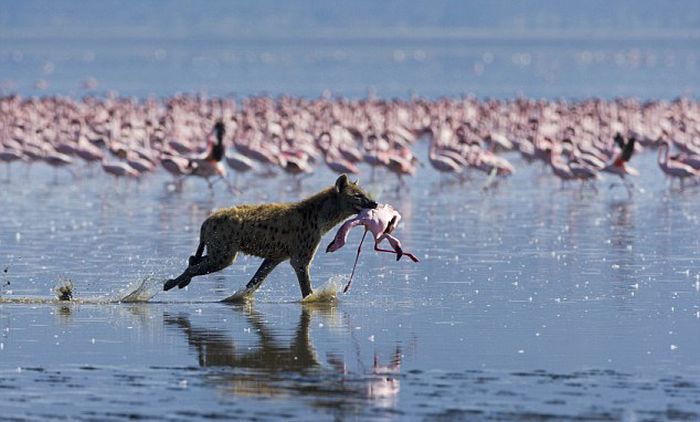|
|
Hyena Catches A Flamingo
|
By 10-12 million years ago, the hyena family had split into two distinct groups; that of the dog-like hyenas and the bone-crushing hyenas. The arrival of the ancestral bone-crushing hyenas coincided with the decline of the similarly built but unrelated Percrocutidae family. The bone-crushing hyenas survived the devastating changes in climate and the arrival of canids, which wiped out the dog-like hyenas, though they never crossed into North America, as their niche there had already been taken by the Borophaginae family. By 5 million years ago, the bone-crushing hyenas became the dominant scavengers of Eurasia, primarily feeding on large herbivore carcasses felled by sabre-toothed cats. One genus, Pachycrocuta, was a 200 kg (440 lb) mega-scavenger that could splinter the bones of elephants. With the decline of large herbivores by the late ice age, Pachycrocuta was replaced by the smaller Crocuta.
• Rise of modern hyenas
The aardwolf can trace its lineage directly back to Plioviverrops 15 million years ago, and is the only survivor of the dog-like hyena lineage. Its success is partly attributed to its insectivorous diet, for which it faced no competition from canids crossing from North America. Its unrivaled ability to digest the terpene excretions from soldier termites is likely a modification of the strong digestive system its ancestors used to digest foetid carrion.
The striped hyena may have evolved from H. namaquensis of Pliocene Africa. Striped hyena fossils are common in Africa, with records going back as far as the Middle Pleistocene and even to the Villafranchian. As fossil striped hyenas are absent from the Mediterranean region, it is likely that the species is a relatively late invader to Eurasia, having likely spread outside Africa only after the extinction of spotted hyenas in Asia at the end of the Ice Age. The striped hyena occurred for some time in Europe during the Pleistocene, having been particularly widespread in France and Germany. It also occurred in Montmaurin, Hollabrunn in Austria, the Furninha Cave in Portugal and the Genista Caves in Gibraltar. The European form was similar in appearance to modern populations, but was larger, being comparable in size to the brown hyena.
|
|









